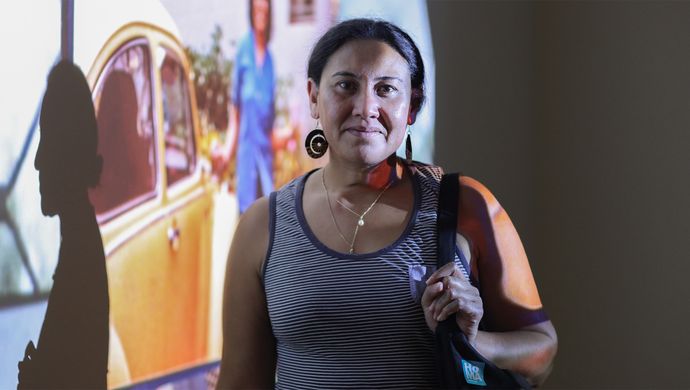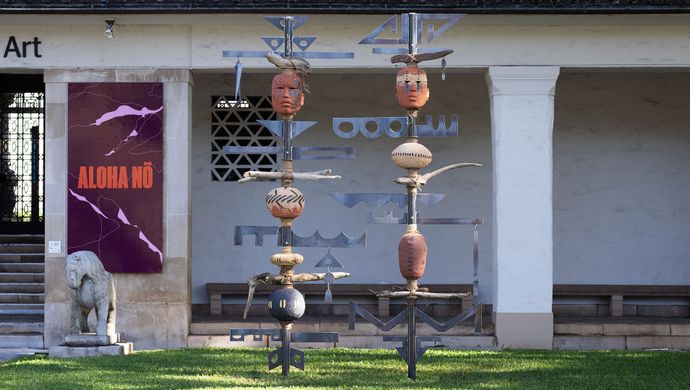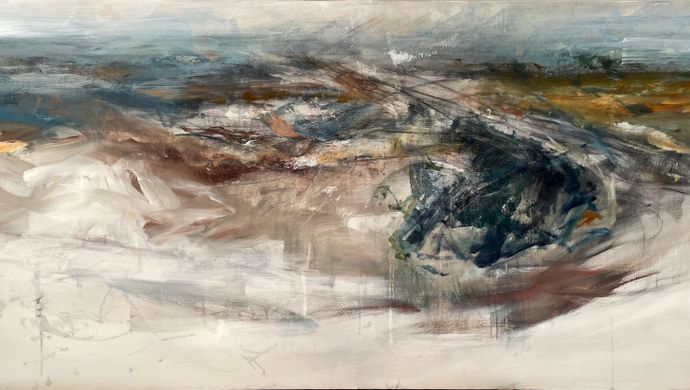What the Hawai‘i Triennial 2025 has in store at HoMA
Here’s a preview of what you’ll experience at HoMA. On view is work by Edith Amituanai, Teresita Fernández, Hayv Kahraman, Al Lagunero, Gisela McDaniel, Citra Sasmita, Rose B. Simpson and Kanitha Tith.
Collectively their work explores the notion of womanhood as a journey of vulnerability and resiliency, tenderness and strength. Understanding the female body as a site of violence and colonization as well as a source of creation and healing, ALOHA NŌ at HoMA underscores the aspects of aloha that persevere through adversity.
“With these artists at Honolulu Museum of Art, the curators have developed a theme around womanhood as both central to family, healing and community, as well as the target of power and administrative control,” says Tyler Cann, HoMA’s senior curator of modern and contemporary art.
The Triennial theme ALOHA NŌ invites us all to [re]consider our notions and preconceptions of aloha. It is a call for deeper understandings of love, solidarity, care and transformation. There is a lot to see at sites throughout town and, for the first time, on Maui and Hawai‘i Island, including Bishop Museum, Capitol Modern, Foster Botanical Garden, East Hawai‘i Cultural Center, and the Triennial’s Hub at Davies Pacific Center at 841 Bishop St.
See all the sites of exhibition and programming
Here’s what to expect at HoMA:
Front lawn
Visitors to HoMA will be greeted by mixed-media artist Rose B. Simpson’s ceramic-and-steel sculpture on the front lawn. Titled A’gin, the work consists of two stacked figurative beings. A’gin means to “respect” in Tewa, and the artist approaches her art with the utmost respect for her Indigenous culture and community. The work also considers the environmental impact of artmaking itself, with Simpson intentionally considering the carbon footprint of the sculpture. The artist lives and works in Santa Clara Pueblo, NM.
In Gallery 28
Teresita Fernández’s monumental floor installation Volcano (Cervix) confronts the systemic exploitation of women’s bodies in the Caribbean. Using solid charcoal and black sand, the work assembles the region’s individual island shapes into an abstract chain resembling a cervix. Drawing on Puerto Rico’s history as a testing ground for eugenics and experimental contraception, Fernández connects the abuse of women’s bodies with ecological devastation and colonial oppression.
Hayv Kahraman presents Gamla and Barghouth (The Louse and the Flea), an installation of two large paintings on marbled, hand-woven flax embedded with silicon carbide, materials that evoke both fragility and resilience. The paintings are inspired partly by the Iraqi folktale The Flea and the Louse, about cumulative downfall that also foregrounds the relationships between species, including our own. The ecology and cosmology of Hawaiʻi also emerges in Kahraman’s work, including reference to the ōhiʻa lehua tree and critically endangered endemic snails. In each of these layers, Kahraman sees the generative and restorative potential of grief as we imagine a more interconnected and resilient world. Kahraman spent time on Hawai‘i Island and O‘ahu, where she worked closely with Bishop Museum malacologists and studied their snail collection.
Gisela McDaniel’s three new oil paintings focus on images of women and their relationships to each other and within their community. The paintings are accompanied by audio of recorded interviews with her subjects. Her subjects include Guahan (Guam) activist Moñaeka Flores and traditional healer Mama Chai, who recently was threatened with arrest by the U.S. military while she was harvesting medicinal plants in northern Guam. The American visual artist is of CHamoru descent, Guam’s Indigenous matrilineal society.
Al Lagunero produced his four paintings during a residency at the Manoa Heritage Center, the former home of missionary descendent Charles Montague Cooke, the son of the founder of the Honolulu Museum of Art. This site has deep meaning for Lagunero. His great-grandmother Ka‘aha‘aina-o-ka-haku Naihe was a healer on Hawai‘i Island. When Cooke was born prematurely in 1874 on O‘ahu, his parents sent for Naihe, who treated him with traditional Hawaiian healing arts. Lagunero’s works reconnect him spiritually with his great grandmother.
Citra Sasmita is a contemporary artist from Bali whose work focuses on unraveling the myths and misconceptions of Balinese art and culture. Her work Timur Merah Project XIV: Tribe of Fire explores the role of fire in Balinese cosmology. The project highlights fire’s transformative and purifying powers in rites from birth to death, while celebrating the role of women as spiritual mediators and key figures in maintaining cultural and cosmological balance.
Kanitha Tith’s art practice embraces laborious, meditative processes to evoke a sense of freedom. In addition to her work as an artist working across a range of mediums, Tith is active in Cambodia’s independent cinema industry and associated with the award-winning production company Anti-Archive. For HT25, she presents a set of wire sculptures and watercolor paintings.
Her hand-woven sculptures are created without predetermined designs, evolving slowly through a process of coiling, questioning, and adjustment. Oscillating between figurative and abstract forms, Kith’s work draws from both personal experiences and Cambodia’s complex collective memories.
In Gallery 14
Edith Amituanai’s film Vaimoe will be screened on a loop in Gallery 14. The film centers on the artist’s aunt, Vaimoe, who returned to Samoa after living in the US for many years. In this moving story Vaimoe finds a Samoa very different from the one she left, and she reflects on her life and the hardships she has experienced. An artist of Samoan heritage who lives in Aotearoa New Zealand, Amituanai explores historical and familial connections between Tonga and Samoa.
Learn about all the artists in ALOHA NŌ



 Story
Story


